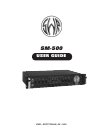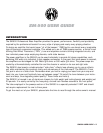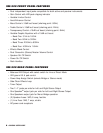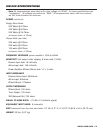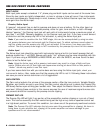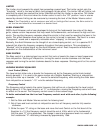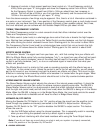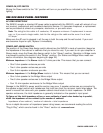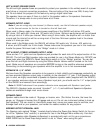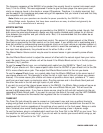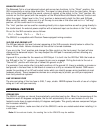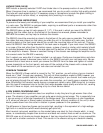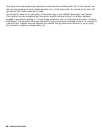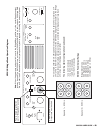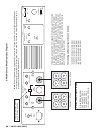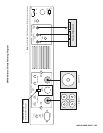
6 • SM-500 USER GUIDE
4. Keeping all controls in their present positions (Level control at +15 and Frequency control at
40Hz), strike your open “E” string again and move the Frequency control from 40Hz to 160Hz.
As the Frequency Control is moved from 40Hz to 16Hz you should hear two increases in
volume. The first will be at 80Hz or your first overtone (harmonic) and the second will be at
160Hz or the second harmonic of your open “E” string.
From the above example a few things may be apparent. One, there’s a lot of information contained in
one note on your instrument. Two, if one position of the Frequency control gives a much louder sound
or volume, you may have found the area of greatest efficiency of your speaker cabinet. And, three,
the tonal variations you can achieve with the Variable Graphic EQ are just about infinite!
TREBLE/TRANSPARENCY CONTROL
The Treble/Transparency control is a dual concentric knob that offers individual control over the
Treble and Transparency functions.
The Treble control (outer knob) is a shelving-type tone control that cuts or boosts the high frequen-
cies. Starting from mid-position, turning the Treble Control counter-clockwise cuts the high frequen-
cies, while turning the control clockwise boosts them. Shelving point for this control is about 2kHz.
The Transparency Control (inner knob) is a shelving-type tone control that cuts or boosts the high
frequencies a full octave above the treble function. Shelving point for this control is about 5kHz.
EFFECTS BLEND CONTROL
This function “blends” the signal sent from your bass, etc., with that coming from your effects unit.
With the Effects Blend control fully counter-clockwise (“dry”), no signal from your effect will be heard.
As you turn this control clockwise, more of the effect can be heard in the overall sound. When the
control is set fully clockwise (“wet”), no true or unaffected signal is heard other than what your
effects unit provides.
The Effects Blend circuit is similar to that used on recording consoles with the effects loop on a
“side chain” to the normal circuit. Unless the control is set to the full wet position, you will always
get the full sound of your instrument and get the diversity an effects unit offers. This circuit is also
effective in reducing noise caused by effects units because it is located after the gain stages. When
not using an effect, the Effects Blend control should be set to the fully counter-clockwise position.
STEREO MASTER VOLUME CONTROL
The Stereo Master Volume control adjusts the volume of the internal power amplifiers. It should be
used in conjunction with the Gain control to achieve maximum signal-to-noise ratio. The SM-500’s
Stereo Master Volume control is a dual-concentric knob that offers individual volume control over
both the right side (outer knob) and left side (inner knob) when the SM-500 is being run in the Stereo
Mode. When the SM-500 is being run in the Bridge/Mono Mode, the inner knob controls the overall
volume (the outer knob is disabled and will have no effect in Bridge/Mono Mode).
SPEAKER ON/OFF SWITCH
Moving the Speaker On/Off Switch to the “On” position allows the signal from the amplifier to be
heard through any speaker enclosure(s) connected to the SM-500’s output section. Moving the
Speaker On/Off Switch to the “Off” position disables the SM-500’s output section. This feature
allows the user to:
1. Use the XLR Output without using the internal speakers. This is especially useful in recording
when you are miking the speakers and only a direct signal is required.
2. Tune up without interfering with other band members while using the Tuner Output feature.
Note: If you do not hear any sound when you plug in and your system is properly connected,
check the position of the Speaker On/Off switch.



